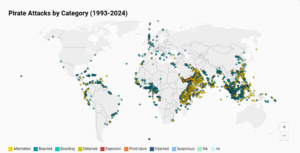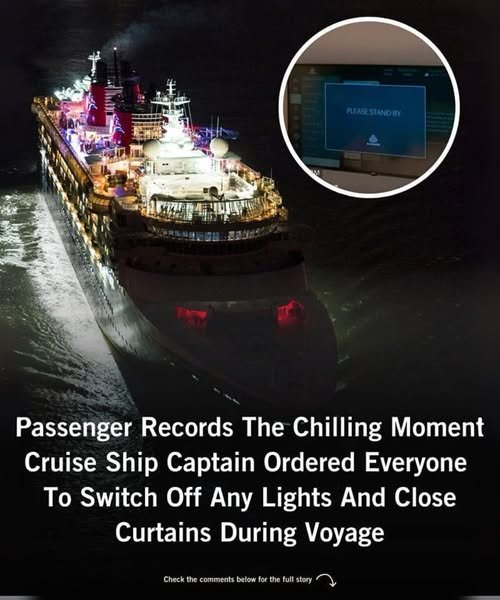Travelling onboard a luxury cruise ship can be an incredible experience, but what many don’t know is that it sometimes happend an unusual “risk.”
In fact, it has recently been revealed by a passenger on the Cunard Queen Anne ship, which is entering into an 111-night ‘maiden World voyage’ from Hamburg, Germany – visiting sights such as New York, Sydney, Hawaii, Penang and Cape Town, alongside passing through the Sulu-Celebs sea – that the passengers were concerned to unplug lights and draw curtains.
In the TikTok video, which has over 8 million views, the captain concerns the nearly 3,000 travellers onboard the cruise ship of a ‘heightened level of security alertness’ as the consequence of traveling through piracy-prone areas.
The external promenade decks shuttering overnight would weaken the ship’s visibility, the person who shared the captain’s announcement on TikTok explained.
As predicted, the video drew the attention of many who said they were unaware of such dangers.
@lillydapink I didn’t know there were pirates around this area. We are crossing from Darwin to Manila #cruisetok #cunard #fyp ♬ original sound – cruisegypsyuk@lillydapink
“Well, that sounds terrifying,” one person commented.
“Not really, it’s just safety precautions, the risk is very low,” the TikToker who posted the video answered.
Another noticed, “Idk why but every time I hear about real life pirates I’m always shocked/amazed that they really exist.”
A third added, “I used to work on a cruise ship and there are a few areas where you get piracy. We used to get a special security company that used to come onboard with g*ns when we go past Somalia. You’re safe.”
Someone else added: “To be honest, if a cruise or passenger ship was attacked by Pirates, the response from naval vessels would be swift and sudden, moreso than if it was a regular merchant vessel.”
Modern Day Pirates: Attack Numbers and Types
Pirates are not an ancient phenomenon. We mapped all pirate attacks between 1993 and 2024 to understand their impact to modern trade.
Few topics are as prone to misconceptions as modern pirates. Likely, when you think of pirates, your mind will drift back some centuries. Naturally, you’ll think of wooden sail ships making their way across the Caribbean, plundering government vessels, and causing havoc across coastal towns. Images of black flags with skulls and bones reign galore.
Yet, this image is mostly mistaken—at least when it comes to our times. We often think of pirates as a historical artifact when, in reality, they continue to roam the seas and threaten imports galore. In fact, they remain one of the most important threats to maritime cargo and, over the last 30 years, have resulted in almost 13,000 attacks on active vessels.
The main difference is that pirates are no longer fighting the government or hiding in abandoned islands. Modern pirates, instead, focus on attacking cargo ships either stealing some of their merchandise or taking over an entire vessel and charging ransom for it. So, it’s n o longer gold chests they are after but, rather, large shipping containers. But just how much do they impact trade world wide?
At Desteia, we wanted to take a closer look at modern pirates and understand their true impact on maritime trade. To do this, we expanded an existing dataset published in the Journal of Open Humanities accounting for all pirate attacks between 1993 and 2020. We added data up to May 2024 using the official data from the International Chamber of Commerce which, every day, reports on any activity related to piracy worldwide. Together we were able to account and track basically every pirate attack from the last thirty years.
First, we found that, although piracy remains a large problem today, occurrences are steadily decreasing. In 2023, the ICC reported 194 attacks in total, down 5.3% from 2022 and 74% from 2022. As it turns out, we’ve seen a steady decrease in piracy since 2010.
If we disaggregate these attacks further, we will also notice that, in reality, the large spikes in the late 2000s were mostly related with an increase in attempted attacks, while the number of successful boardings remained steady. So, modern pirate attacks have been on the fall or have remained at similar levels for more than a decade.
In our data gathering efforts, we also found the actual coordinates of all attacks recorded, allowing us to gain a geographical understanding as to where modern pirates tend to attack. The map below, shows all the attacks across time, with different colors to indicate if pirates successfully boarded a vessel, attempted to board, used fire weapons against a crew, and other categorizations:

You might notice, from a first glance, that a vast majority of pirate attacks are concentrated amongst South East Asia, the Horn of Africa, and the Red Sea. Although the scattered nature of points close to the horn of Africa might suggest this is the most prominent area for pirates, once we actually count them, we find a different truth. As it turns out, 46.9% of all pirate attacks occurred in East Asia and the Pacific, followed by Sub-Saharan Africa with 21.2%. Latin America, for its part, accounted for just 10.3% of all piracy examined, the vast majority concentrated in the northern part of South America.


